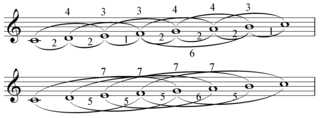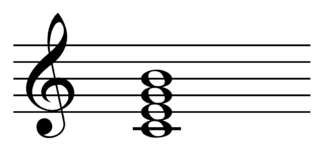

In music, the major Locrian scale, also called the Locrian major scale, is the scale obtained by sharpening the second and third notes of the diatonic Locrian mode. With a tonic of C, it consists of the notes C D E F G♭ A♭ B♭. It can be described as a whole tone scale extending from G♭ to E, with F introduced within the diminished third interval from E to G♭. The scale therefore shares with the Locrian mode the property of having a diminished fifth above the tonic.
The Locrian mode is either a musical mode or simply a diatonic scale. On the white piano keys, it is the scale that starts with B. Its ascending form consists of the key note, a half step, two whole steps, a further half step, and three more whole steps.

In classical music from Western culture, a diminished third is the musical interval produced by narrowing a minor third by a chromatic semitone. For instance, the interval from A to C is a minor third, three semitones wide, and both the intervals from A♯ to C, and from A to C♭ are diminished thirds, two semitones wide. Being diminished, it is considered a dissonant interval.
Contents
It can also be the natural minor scale or Aeolian mode with raised third and lowered fifth intervals. It may also be derived from the Phrygian Dominant scale, but this time, the second is major, while the fifth is diminished.
The Aeolian mode is a musical mode or, in modern usage, a diatonic scale also called the natural minor scale. On the white piano keys, it is the scale that starts with A. Its ascending interval form consists of a key note, whole step, half step, whole step, whole step, half step, whole step to return.

In classical music from Western culture, a third is a musical interval encompassing three staff positions, and the major third is a third spanning four semitones. Along with the minor third, the major third is one of two commonly occurring thirds. It is qualified as major because it is the larger of the two: the major third spans four semitones, the minor third three. For example, the interval from C to E is a major third, as the note E lies four semitones above C, and there are three staff positions from C to E. Diminished and augmented thirds span the same number of staff positions, but consist of a different number of semitones.
In English, Arabian scale may refer to what is known as the major Locrian scale. [1] A version of the major Locrian scale is listed as mode 3 in the French translation of Safi Al-Din's treatise Kitab Al-Adwar.[ citation needed ] This was a Pythagorean version of the scale.

Pythagorean tuning is a system of musical tuning in which the frequency ratios of all intervals are based on the ratio 3:2. This ratio, also known as the "pure" perfect fifth, is chosen because it is one of the most consonant and easiest to tune by ear and because of importance attributed to the integer 3. As Novalis put it, "The musical proportions seem to me to be particularly correct natural proportions." Alternatively, it can be described as the tuning of the syntonic temperament in which the generator is the ratio 3:2, which is ≈702 cents wide.
Aside from this Arabic version, interest in the major Locrian is a phenomenon of the twentieth century, but the scale is definable in any meantone system. It is notable as one of the five proper seven-note scales in equal temperament, and as strictly proper in any meantone tuning with fifths flatter than 700 cents. If we take the tonic in the scale given above to be G♭ rather than C, we obtain the leading whole-tone scale, which with a tonic on C is C–D–E–F♯–G♯–A♯–B; this can equally well be characterized as one of the five proper seven-note scales of equal temperament.

Meantone temperament is a musical temperament, that is a tuning system, obtained by slightly compromising the fifths in order to improve the thirds. Meantone temperaments are constructed the same way as Pythagorean tuning, as a stack of equal fifths, but in meantone each fifth is narrow compared to the perfect fifth of ratio 3:2.

In diatonic set theory, Rothenberg propriety is an important concept, lack of contradiction and ambiguity, in the general theory of musical scales which was introduced by David Rothenberg in a seminal series of papers in 1978. The concept was independently discovered in a more restricted context by Gerald Balzano, who termed it coherence.

An equal temperament is a musical temperament, or a system of tuning, in which the frequency interval between every pair of adjacent notes has the same ratio. In other words, the ratios of the frequencies of any adjacent pair of notes is the same, and, as pitch is perceived roughly as the logarithm of frequency, equal perceived "distance" from every note to its nearest neighbor.
The major Locrian scale is the 5th mode of the Neapolitan major scale, which may be used in conjunction with the Neapolitan chord, but is not limited to it. This scale is also known as melodic minor ♭2. [2] Its modes and corresponding seventh chords are:
In music, the major Neapolitan scale and the minor Neapolitan scale are two musical scales. Both scales are minor, despite their names.
In music theory, a Neapolitan chord is a major chord built on the lowered (flatted) second (supertonic) scale degree. In Schenkerian analysis, it is known as a Phrygian II, since in minor scales the chord is built on the notes of the corresponding Phrygian mode.
- Neapolitan major; CmM7 (add ♭9, 11, and 13) (Dorian mode with major seventh and minor second)
- leading whole-tone; D♭M7♯5 (add 9, ♯11, and ♯13) (Phrygian mode with major sixth and diminished unison) (whole-tone scale plus major seventh)
- Lydian dominant augmented; E♭7♯5 (add 9, ♯11, and 13) (Lydian mode with augmented fifth and minor seventh) (whole-tone scale plus major sixth)
- Lydian minor; F7 (add 9, ♯11, and ♭13) (Mixolydian mode with augmented fourth and minor sixth) (whole-tone scale plus natural fifth)
- major Locrian; G7♭5 (add 9, 11, and ♭13) (Aeolian mode with major third and diminished fifth) (whole-tone scale plus natural fourth)
- altered dominant major 2nd; Am7♭5 (add 9, ♭11, and ♭13) (Locrian mode with major second and diminished fourth) (whole-tone scale plus minor third)
- altered dominant diminished 3rd; B7♭5 (add ♭9, ♮9, and ♭13) (Ionian mode with minor third and augmented unison) (whole-tone scale plus ♭9)
The major Locrian scale has only two perfect fifths, but it has in some sense a complete cycle of thirds if one is willing to count a diminished third as a third: four major thirds, two minor thirds and a diminished third making up two octaves. In 12-equal temperament, the diminished third is enharmonically equivalent to a major second, but in other meantone systems it is wider and more nearly like a third.
In music theory, a perfect fifth is the musical interval corresponding to a pair of pitches with a frequency ratio of 3:2, or very nearly so.




